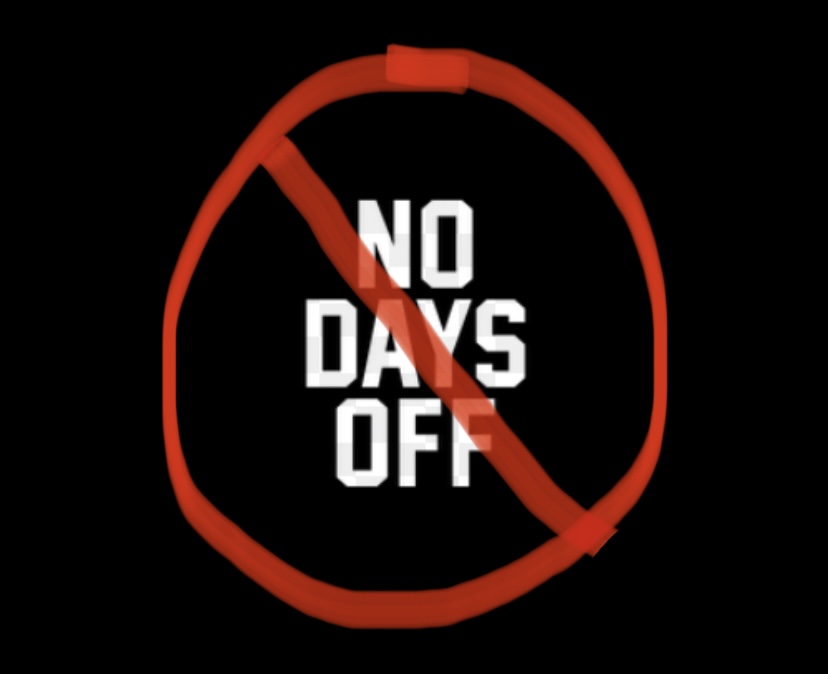I’m starting a new worldwide movement, a movement to decrease injury and promote health in the sports and fitness world. I’m even creating my own hashtag. I’m going to abolish #NODAYSOFF and replace it with #THREEDAYSOFF. Here’s my claim, and I stand by it: Taking three days off from training/workouts will cure 80 percent of nontraumatic sports injuries, IF you intervene early in the injury cycle.
The term “nontraumatic” refers to a repetitive strain or overuse injury, which frequently manifests as an ache or pain that insidiously appears on the scene in your consciousness one day, and over the course of a week or two does not seem to be going away on its own. It may even begin as a feeling of fatigue or weakness in an area of the body that gradually morphs into soreness. I also consider overtraining to be included in the nontraumatic injury category, although this condition is more of a metabolic injury than a musculoskeletal injury. My Three Days Off claim does not apply to traumatic injuries, which result from a specific incident that precipitated the injury. Examples of a traumatic injury can range from a common sports injury, such as an ankle sprain, to a bone fracture, concussion, or whiplash injury from a fall or accident. While a traumatic injury will benefit from rest, it frequently also requires more specific intervention.
Three Days Off is such an easy and effective intervention to implement, but so many of my clients rebel against the concept. I understand! The snow may be perfect, the weather may be amazing and most of us have a limited window of time in which we can get in a workout, train for an event, or get outside. We have no intention of letting anything, especially our own bodies, stop us, so we run, bike, swim, ski, play tennis or do whatever it is we do, full speed ahead. And we frequently go from zero to 100 percent when our season begins, without gradually building our training load to reacclimate our bodies to our sport. We also frequently neglect important strengthening and flexibility work that would support our training and reduce the likelihood of injury.
So, what’s the problem? When we are performing the same set of movements against resistance over and over, day after day, we set ourselves up for an overuse injury and/or an overtrained state. In the case of an overuse injury, muscle fibers do not have adequate time to recover and start to break down. You may notice this phase initially as a feeling of weakness or fatigue. It may then progress to a constant feeling of tight, sore muscles–a reflexive pattern established by your brain to limit the mobility of a vulnerable area of the body. And if you push through this phase without time for rest and recovery, you likely will start to feel acute pain somewhere, either in the area of overuse, or elsewhere in your body. This happens when your brain remaps the injured area and establishes compensatory motor patterns as output to protect the injury. In other words, you start to move differently and put stress on other areas of your body in order to protect an injured area.
Overtraining is a separate condition from overuse. It is essentially an energy-depleted state resulting from too much physical stress to your body. You have depleted your glycogen stores by not refueling adequately and not allowing yourself enough recovery time. Glycogen is the storage form of glucose, a simple sugar derived from the breakdown of carbohydrates that you eat. Glycogen is stored primarily in your muscles and liver, and is converted back to glucose when needed to supply the human brain and body with energy. The glycogen to glucose process deserves and someday may have its own separate blog, but the takeaways for you right now are: 1) Carbohydrate intake is needed for the glycogen to glucose breakdown process to fuel your training, and 2) too much training without adequate refueling and recovery time, especially in combination with silly no-carb diets, can manifest as a feeling of constant low energy or fatigue, muscle soreness, and decreased sports performance. Clients will say, “I don’t know what my problem is, I’m dragging, I’ve been training nonstop and I’m getting slower. I was faster a month ago.”
I know, I’m so boring, I really am sorry. But please stick with me here for another minute because this is important: This is the point where many people get annoyed with themselves. They think they’re in pain because they must be out of shape, and continue to push through. They may be influenced by the jungle of bad social media fitness advice, nonsensical Internet articles telling us that our muscles will become flaccid if we take more than a day off from workouts, or loudmouths at the gym bragging about how great they are at blocking out pain, and you should, too (These are generally the people who in five years will be recovering from a rotator cuff repair or L3-L4 fusion). This is the pivotal point at which you can choose to power on into a possibly chronic injury condition that can persist for months or longer, or you can choose to stop the injury in its tracks and heal it. Understanding the science behind my Three Days Off claim hopefully will help you to make a strong decision.
What of monumental importance could possibly happen in three days? Quite a bit:
- Full muscle recovery from strenuous workouts occurs in approximately three days. Delayed-onset muscle soreness, caused by microscopic tears in the muscle fibers may start within 12 to 24 hours but can last up to 72 hours. Three days off allows muscles to recover. Respecting this recovery period will help to clarify if you have an injury that requires intervention, or if you just needed a rest.
- The acute inflammation phase of soft tissue injury is subsiding, and the proliferative phase of cellular healing is beginning. The inflammation phase at the beginning of an injury is your immune system’s response to tissue damage, and appears as soreness and/or sharp pain, swelling, redness, and heat. It peaks and will be settling down within approximately three days. Your body will begin to replace damaged tissue with new, healthy tissue IF you take three days off and do not contribute to continued tissue damage and inflammation by training through it. Applying ice to the area of injury can help to calm your nervous system and decrease the pain and swelling of the inflammation phase. Once the inflammation has settled down, applying heat for short periods can locally increase circulation at the injury site, which will benefit the proliferative phase of healing.
- Glycogen stores in your muscles and liver are restored, replenishing your energy supply. For this to happen, you must be hydrating and eating a lot of healthy, nutritious food, including the C word that the everyone hates (carbohydrates). This is when a big pasta dinner really comes in handy. A carbohydrate-heavy meal will increase your rate of glycogen synthesis. After a hard workout, it can take up to 24 hours to replenish glycogen stores. In overtraining situations, three days is a good amount of time to replenish fully depleted glycogen stores. In a more severe case, such as after a period of strenuous training or racing in extreme weather, you may be dehydrated, and you may have depleted your electrolytes in addition to depleting your glycogen stores. You might need an additional three days or more off to recover.
- Three days off is a good mental break from training and training-related stress. To benefit from this mental break, you must commit to helping the healing process by embracing the three days off and adopting a loving and healing attitude toward your body. Self-flagellation for taking three days off will not help. Physical and mental stress contributes to excessive production of cortisol by your adrenal glands, which contributes to tissue breakdown, inflammation, and difficulties with your sleep/wake cycle. Think of the three days off as a fun little vacation during which you’re allowed to sleep in, eat a lot, and relax! Rest and de-stressing help to bring your cortisol levels back under control. Three days is a good amount of time to pause and evaluate your training, perhaps with the help of a coach or other professional. You can restructure it as needed to avoid injury and overtraining, and formulate a plan for gradually returning to injury-free training.
What should you do at the end of Three Days Off? Here is your pathway:
- Assess how you feel. If you are pain-free, you may test things out with a short, fun recovery ski, swim, run, or bike, or a short practice, for the love of the sport only and to shake the dust off. You are not to resume anything resembling training on this first day.
- Reassess how you feel after your recovery workout. A little soreness after resuming activity is OK if it goes away and if it can be controlled with ice. You can begin to gradually resume training, preferably every other day and/or with some cross-training. Continue the reassessment after each workout. If the symptoms are still kicking around, scale back the training to a level where you no longer feel them, or take another three days off. Depending on how inflamed you were to begin with, you may need a longer rest period.
A very wise friend of mine always says, “A little extra rest never hurt anyone.” It’s the consistency of training combined with recovery time over years that builds us into strong athletes. Three Days Off as needed will only benefit you and will not harm you. Frequently, athletes emerge from a rest period well rested, fully energized, less stressed and more excited to get back to training, while exhibiting significant performance gains. Well-trained athletes can take 10 days or more off and benefit from rest without any significant loss in their conditioning. They also can take more time off from their specific sport if needed by using pain-free cross training. Examples of cross training are biking and/or swimming if you are a runner, rowing or paddling if you are a swimmer, and spin biking if you are a skier. In addition, using the time off from your sport to improve your strength and flexibility will only benefit you. It also is immensely confidence-building to rehab yourself through an injury.
If you have tried multiple rounds of Three Days Off and your injury has not improved, then it’s time to consult a health care provider for assistance with determining the cause of your injury and strategies to heal it. Frequently, an imbalance of strength and/or mobility, as well as an imbalance in your life and your approach to training, are contributing factors to overuse and overtraining and can easily be addressed. If the injury returns in the future, you can view it simply as an indicator of your body’s need for rest and preventive self-care, and now you know what to do: #THREEDAYSOFF
Kathleen Doehla, M.S. P.T.

